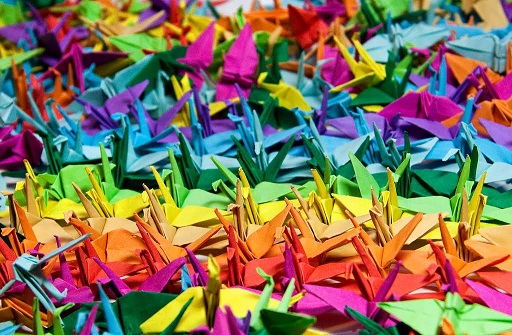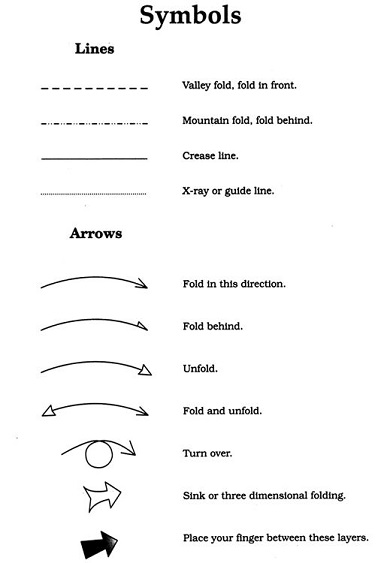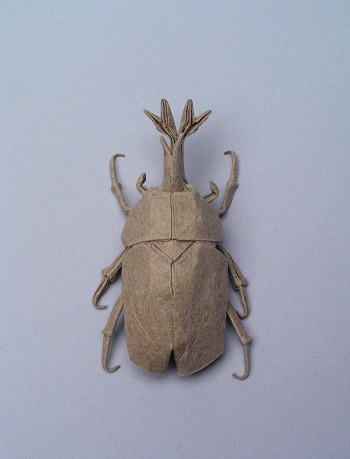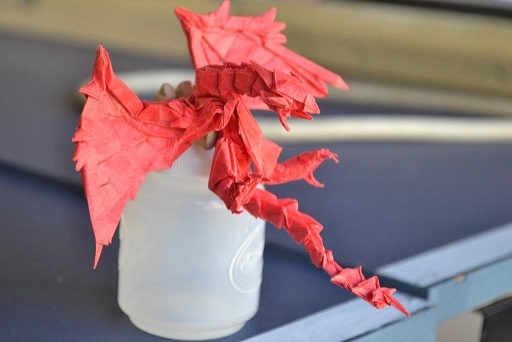 An origami butterfly, folded from Akira Yoshizawa's famous design. Origami is the most common name for the art of folding paper, primarily into representative models and other objects. An origami model can be folded from a single piece of paper, without any cuts (in fact, for many people this is a defining feature of the art form) - but this does not mean that models cannot be made from multiple pieces of paper or cannot include cuts in the process of crafting a model. Although the use of the term "origami" - deriving from the Japanese "oru", to fold, and "kami", paper - reflects the most commonly known Japanese paperfolding traditions that are a significant part of the hobby, people all around the world fold paper, due to its affordability and appeal as an activity that can be performed communally, by a wide range of people. Isao Honda states in The World of Origami: "Origami, for which all you need is a sheet of paper, transcends differences of wealth, station, or race and makes all equal." I myself have enjoyed origami since elementary school, and though I am far from an expert (I can't do an open sink or read a crease pattern to save my life) I am excited to see who else in the community folds, and also to potentially introduce more people to origami. Don't feel discouraged by the meticulous models of scorpions or hydralisks (or anatomically correct hearts with electronics and LEDs to simulate heartbeat and bloodflow) that you may have seen. If you are interested start with simpler models and work up from there. Origami is unique in that the process of folding a paper model is considered just as much an art as the finished model itself. There is a lot of excitement and joy to be found even in the simpler models, and the way that origami artists translate certain complex features of a cat or a flower through a few folds is something to be admired.  Even the simplest of models can be vibrant and beautiful. A very brief history of origami Origami as we know it today is the result of the melding of several different international paperfolding traditions that developed independently of each other. Paper was developed in China in the first centuries of the Common Era and introduced to Japan by Buddhist monks. It is unknown as to whether the Chinese had their own folding tradition or whether the Japanese started creating origami (known at this time as orikata, "folding shapes") independently. Japanese models were simple, primarily passed down from mother to daughter, and were used either for religious/ceremonial purposes or for decorations on gifts. In the 8th century, paper had reached the Muslim communities in North Africa and the Middle East, and these peoples began their own paper folding traditions. Since Muslims at the time strictly followed religious codes forbidding them to create any kind of representational images (like the birds and boats of the Japanese and European paper folding traditions), they primarily used paperfolding as a means to explore the intricate mathematic systems which they contributed to society, making geometric shapes and other abstractions from folded paper. 3D geometric "modular" origami, and other abstract origami forms such as tesselations, are a part of the art form that are practiced, refined, and respected to this day. Muslim communities spread paper to Europe, and they likewise developed folding traditions. Of note are the development of paperfolding in two countries: Spain and Germany. In the 12th century Islamic people introduced paper, and with it, paper folding, to Spain - and the Spanish practice of papiroflexia derives from the Muslim tradition of intricate, abstract models. After the Muslims left Spain, Spaniards began folding representative models. However, you can still see hints of the Muslim geometric tradition in the most popular origami design of Spain, the "pajarita", a paper bird made from stark, sharp geometric shapes, with a crease pattern of squares, triangles, diamonds and many right angles. The pajarita is so popular in Spain that many refer to origami as "folding pajaritas". In Germany origami primarily developed in the 19th century with a man named Friedrich Froebel, who invented the concept of kindergarten. Echoing the inspiration of Islamic communities using paper folding as a geometrical exercise, Froebels used paper folding as a tool to teach basic mathematical concepts to young children in the classroom. Perhaps the biggest influence German paper folding has had on modern origami is this direct link between origami and the classroom which, along with the Japanese practice of passing down model instructions to children, has led many to associate origami with children and dismiss it as a child's craft. However, in the modern day, origami is becoming more and more significant both in its application in scientific fields but also as a means of expression. There is a ton of fascinating overlap between origami and science - the concept of a structure folding in on itself has been used to create things as small as heart stents or as large as solar arrays in space. However, I wish to focus on origami as an artistic expression, for it is under this umbrella which the independent traditions unite - the practice of paper folding around the world represents a desire to create a dynamic figure. The origamist creates life out of death not only literally in creating a model from an inanimate square of paper, but creates as an act of resistance. While the traditions of modern origami developed practically independent of each other, origami as an international practice of peace began in the mid-20th century, and can be traced in large part back to one person: a young girl named Sadako Sasaki. Sadako, the senbazuru and origami as a communal, nonverbal plea for peace Sadako Sasaki was two years old when she and her mother escaped from their home on 6 August 1945 - just a little over a mile away from where Little Boy hit Hiroshima, Japan. Sadako was hit directly by the blast, but survived with no apparent injuries. Ten years later, she was diagnosed with severe leukemia, many cases of which were developing in children who were affected by the bombs. In the hospital, she learned of the Japanese myth that if one folds a thousand paper cranes, they get a wish - a tradition known as "senbazuru". So she began folding many of the traditional model, using scrap papers that were given to her around the hospital, wishing that she would get well. But as her condition worsened and she saw her hospital-mates around her dying, she realized that she would not survive her illness. Instead of wishing for her own health, she began to wish for peace in the world, that "no one else would have to die" in the way that she would. The details are a little fuzzy from there. An online exhibit from the virtual Hiroshima Peace Museum states that Sadako succeeded in her mission within a month, but kept folding as a symbolic gesture. Interestingly, however, most retellings of Sadako's story state that she didn't even get anywhere near succeeding before passing away. The most famous interpretation (Eleanor Coerr's 1977 Sadako and the Thousand Paper Cranes) states that she folded 644 cranes, and that her classmates folded the rest, burying them with her. Today a statue of Sadako adorns the Children's Peace Monument in Hiroshima; every year thousands of cranes are sent to the memorial and displayed, as visitors observe silently, engraving the statue's accompanying epitaphic message into their own hearts. "This is our cry. This is our prayer. Peace in our world." I do not know what really happened - but I think the latter interpretation is interesting because it demonstrates the importance of expressing yourself, even in the face of abject failure. In this way Sadako's story becomes more than a reminder of the lingering effects of war on the innocent (particularly nuclear warfare) - it becomes almost a desperate plea for peace, a resistance against the dying body and against oblivion itself. The modern practice of origami reflects this kind of expression in many similar ways. It is not just the finished product that is respected but the act of folding itself. Though the intricate models are studied and revered, it is more common to see a group of people learning how to fold a model, or mass-folding flowers or cranes as a project or a gift. If there was ever someone at one of your school who fell seriously ill, perhaps you and your classmates got together to fold a thousand paper cranes for them. Origami has become a form of peaceful action against all kinds of pain in life, a means by which the self is healed physically and mentally by this calming act of creation, but has also become a means of expression of environmental issues. Many origamists advocate the use of scrap paper and material that would normally be thrown away to create art. Michael LaFosse has even published a book focusing on creating origami models from recycled material. I think origami can help bring peace to your life, too.  The Children's Peace Memorial in Hiroshima, Japan. Cranes are on display around the statue of Sadako. What differentiates origami from other art forms/crafts? In the creation of a folded paper model, one transmutes a shape into a figure with life and personality. Though there are no strict origami "rules" and the addition or removal of paper is certainly allowed, a lot of modern origamists have an image of origami as a single unbroken piece of paper being transformed into a representative figure. In this framing, one does not remove from the medium like a sculptor chisels away marble or clay, nor do they add to the medium like an artist adds paint to paper. An interesting way I've heard this said is that origami is the only art that follows the First Law of Thermodynamics - that matter cannot be created or destroyed, only changed - but it's more than that. It's sort of like a sculpture, but unlike a sculpture, the directions to creating a finished model are more than just a means to an end - they are an intrinsic part of the art form itself. Origami inherently has performative elements to it, and even when working solo it is easy to find satisfaction in completing a difficult fold or doing some detailing crimps on a nearly-complete model. Kunihiko Kasahara said it much more eloquently than I ever could: Kunihiko Kasahara posted:Origami is a game that one plays with paper. There are people who call it an art. I suppose that this is a reflection of the natural desire to obtain recognition and a high evaluation for the things that a person finds interesting. I share this desire, but I prefer to call origami a game because there can be no more magnificent amusement than one that enables me to use my hands in such a way that from my fingertips birds fly, flowers bloom, and human figures come to life. What do you need to fold origami? You need: hands, a flat surface, and paper, preferably square paper. It is very easy to acquire all of these things, and if you're missing one or multiple of them it's easy to find someone to help you out. That's it! You can get specialty origami paper if you like with different patterns, but please feel free to use any scrap paper you can get your hands on. Okay, I've got everything. When are you gonna teach me how to fold cranes with my face? The best place to start is to look online for tutorials for basic models. Let's start with a traditional paper crane, which you either already knew or have just found out reading this topic is one of the most prominent designs in all of origami. Paper Crane Instructions You'll notice that the majority of online instructions you come across are printed like this: instructions without words, with lines and arrows detailing where to fold and in which direction. This is the Yoshizawa-Randlett System of notating origami and here is how to read it:  The Yoshizawa-Randlett system was innovated because there was a problem in the lack of clarity of origami instructions. It was difficult to convey how to perform certain folds using only language and no clear visual map. This system uses symbols with clear meaning to show exactly what needs to be done to the paper to reach the next step of the design. This is another way that origami is different from other art forms - whereas a painter may have to explain their technique, or a sculptor have to discuss the tools they use, origami does not even need language to interpret and perform it. But it certainly helps. There are now tutorials on Youtube that provide an additional visual aid of showing the steps in action leading to the final model. Here's the first Youtube result when I searched for "origami paper crane", as a visual aid(note the Yoshizawa-Randlett notation being played in the upper-right corner alongside the rest of the video). This is fun. What's the next step? As your interest in origami grows you may find yourself wanting specialty paper or seeking out books by certain origamists to study their models. You can find paper in fancy designs, patterns and textures made specifically for origami, like "Elephant Hide", etc. Typically paper like this has to be special-ordered. Here are some resources: Origami-Shop sells wide varieties of paper, and also sells Michael Lafosse's "Origamido" paper, hand-created for the purpose of folding origami. I like using more affordable papers. If you don't just want to use scrap paper, you can of course get a ream of colorful paper and cut it to your liking when you want to do models. However, if you want kami paper, paper that is white on one side and has a color or design on the other, you'll have to go to a craft store (which will charge through the nose for this paper). It's hard to find affordable paper in the United States this way. However, if you have a Daiso Japan near you, they always sell huge varieties of colorful, perfectly serviceable origami paper. You'll eventually want to seek out some books, as many origamists only circulate their designs commercially. So pick up some books and support these artists. I do have one recommendation:  Kunihiko Kasahara's Origami Omnibus: Paper Folding for Everybody If you only pick up one origami book, make it this one. Kasahara is a genius, and this extensive book is filled with a variety of designs that run the gamut from organic to geometric, from simple and easy-to-replicate all the way to quite complex models. Kasahara also dots the book with his own personal observations and philosophies about the craft.  A Japanese rhinoceros beetle in origami, by Robert J. Lang Which other origamists should I look out for when looking for books? Here are the names that will pop up a lot. Become familiar with their styles and collect the books of the origamist you like best: Akira Yoshizawa: A legend and grandmaster of paper folding. While I give a lot of credit to Sadako Sasaki and her story for bringing origami into the general consciousness, Yoshizawa is the father of the craft itself in the modern day. Left his industrial job in the 1930s to live a life of poverty folding origami, his innovation of the Yoshizawa-Randlett diagramming system was a key step in the path to origami becoming an international hobby. Also began the practice of "wet-folding", intentionally wetting a piece of paper in the process of folding it into an origami design to give it a unique, "organic" appearance. His butterfly is one of the most popular models today. Isao Honda: One of the first popular origamists internationally. His book The World of Origami was one of the first widely well-received books in the publication of origami models. The World of Origami is interesting in that many of the models are composed from non-square paper, and from multiple pieces of paper. Robert J. Lang: A brilliant origamist revered for his complex designs and their almost organic qualities. After a successful career as a literal rocket scientist, Lang began focusing on origami full time. Robert Lang is the go-to name for those who are interested in the mathematics behind origami - he even has publications talking about the mathematical properties which he uses when creating his own designs. Florence Temko: A pioneer of origami in the United States who brought many people into the fold. She was very prolific; when she passed away in 2009 she left behind a legacy of 55 published books on papercrafts. Kunihiko Kasahara: My personal favorite origamist. Focuses on origami as an exercise in creating life and emphasizes the importance of the creative act itself leading to the finished designs. He has published several books aimed toward beginners, so Kasahara is a great person with which to start. Meenakshi Mukherji: An origamist who became fascinated with the craft when she discovered geometric designs. Her books on modular geometric origami are highly-respected. In the same vein are origamists like Tomoko Fuse, who specializes in geometric designs, as well as her Japanese contemporaries like Toshie Takahama and Mitsunobu Sonobe. Michael Lafosse: Operator of the Origamido studio who has many publications and designs to his name. John Montroll: A contemporary of origamists like Robert J. Lang, published primarily models of animals and birds. Had some collaborative projects with Lang like Origami Sea Life. This doesn't even begin to scratch the surface - I know I fail to mention contemporaries across the pond like Robert Harbin, just because I know so little about the origami scene in Europe, nor do I mention other prominent names like Toshikazu Kawasaki or Jun Maekawa, But this will give you a very brief list of some names that you will likely see and want to look for.  Origami Rathalos by timsorigami So, in summary: 1) Get some paper, hands, and a flat surface on which to fold 2) Get some instructions for an origami design you like, either by Googling for instructions or getting a book 3) Fold! 4) Post in here with pictures and results. Or talk about your favorite origamist or design. Or share your own designs, if you've made some. If I have failed to mention anything please PM me so I can add it to the topic. I wanted to cover the basics, so I know there are things I haven't covered in detail like crease patterns and things like that. That said, I hope I've been able to convey why origami is so compelling and powerful to me. Additional resources http://www.origami-instructions.com/ This website has a lot of tutorials for simple models. It also contains informational pages which will be helpful, such as information on the "bases" from which so many origami models are based. http://www.origamispirit.com/ The website of Leyla Torres, an origamist I like a lot. She has a ton of Youtube tutorials for origami that are well-shot and easy to follow. https://www.youtube.com/watch?v=user?jonakashima The Youtube site of Jo Nakashima, another Youtube origamist. Has made a lot of cute designs. https://origamiusa.org/ Website for Origami USA, the United States origami society. http://www.britishorigami.info/ Website for the British Origami Society. Happy folding =) Electric Lady fucked around with this message at 16:42 on Sep 24, 2016 |
|
|
|
|

|
| # ? Apr 26, 2024 19:23 |
|
Find any exciting models online and it seems like they're okay to share? Post them here! I found this shell "Jamie's Camino" linked from another origami site. It's a great model that's simple but also really sharp-looking, and there's also a bit of 3D shaping involved which is always fun. You can find the instructions here: http://forum.origami.vn/index.php?threads/diagram-jamie-s-camino-vo-so.1663/ Here are my attempts. First attempt on the right, second on the left:  I was a lot more careful on the second (red) one, and I did it in one sitting, too, as opposed to several haphazard sittings. The first (burnt orange) one is rather embarrassing and lopsided. But it was my first time trying the model, too. Never be afraid to fold another of a model if the first one doesn't come out too great, as the next one will be better. Of course, my paper is a lot thinner, so mine don't have nearly as nice a "volume" as the ones folded with thick paper on the instruction pages.
|
|
|
|
|
Fantastic post, thank you. I've dropped in and out of origami for many years now, and you've inspired me to go and get some paper today. Don't hold your breath for any examples of my terrible attempts though.
|
|
|
|
Thank you! I do still need to go through and add more information, which I will be doing periodically. What kind of paper have you found? Plain kami paper, or any nice patterns? I have some origami paper that's "travel" themed and has a lot of city maps on it. I think I picked it up from the Daiso or another shop in Japantown in San Francisco. It looks wonderful but I'm afraid to use it. And if you feel comfortable posting your models, please post them =) No one should be afraid to share.
|
|
|
|





